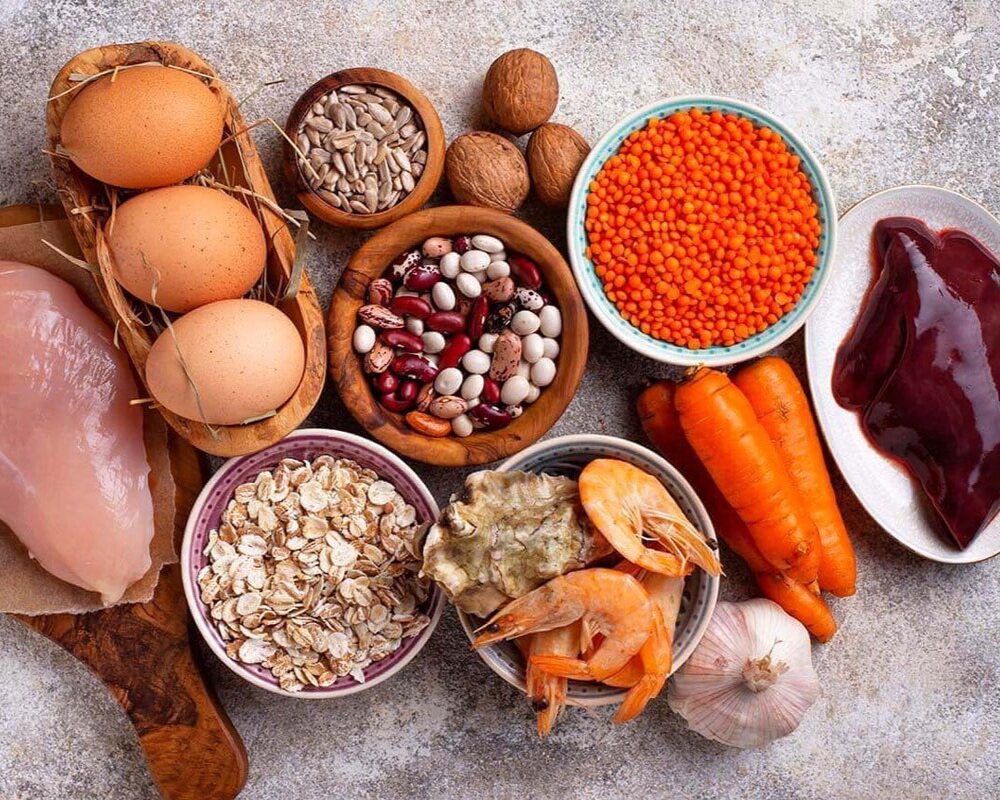What foods contain the most zinc?
Simple foods rich in zinc. What and how does zinc affect?
Zinc is one of the most important elements for every person. It is part of hundreds of enzymes, proteins that perform protective functions. Its content in the body is small and varies from two to three grams. Most of this substance is found in the nervous, muscle, and bone tissues, as well as in the kidneys, liver, and glands.
Zinc is essential for our health. Eating zinc-rich foods is good for helping you recover faster after exercise. The human body cannot synthesize zinc, so you need to ensure that this trace element in sufficient quantities enters the body along with food.
We all know about the benefits of micronutrients such as magnesium, calcium, potassium, iodine, and iron. But zinc, it would seem, is completely invisible and therefore not a very necessary trace element. Meanwhile, the content of zinc is very important for our body, especially in the autumn-winter period, since this trace element helps the absorption of vitamins and supports immunity.
We will tell you why we need zinc and in which products it can be found in sufficient quantities.
What and how does zinc affect?
Zinc affects many vital functions of the body, such as vision, immunity, skin health, and more. So what and how does zinc affect?
Zinc increases resistance to colds. Zinc affects the function of T cells, as well as DNA self-reproduction, which directly affects the state of the immune system. Simply put, people who are deficient in zinc are more likely to get colds.
Zinc improves vision. For good vision, vitamin A is needed, and in order for vitamin A to be absorbed normally, zinc is needed. A diet rich in zinc improves the quality of night vision. In addition, zinc reduces the likelihood of age-related macular degeneration, which leads to loss of vision.
Zinc keeps your skin healthy. Like most vitamins and trace elements, zinc affects not only the internal state, but also the appearance. Zinc is essential for the healing of wounds and cuts. In addition, zinc supports the health of the digestive tract, which affects the condition of the skin.
Zinc is involved in important processes in the body:
has a positive effect on blood sugar levels;
promotes healthy blood circulation;
normalizes blood pressure;
helps in the fight against acute intestinal infections;
increases reproductive function in men and women;
supports liver health;
promotes rapid skin regeneration;
helps to properly absorb fats and carbohydrates;
increases concentration and improves memory, improves brain function;
has a beneficial effect on the condition of hair and nails;
regulates the sebaceous glands;
strengthens the nervous system;
strengthens the skeletal system and teeth.
Adequate zinc levels in the body can reduce the likelihood of respiratory infections, pneumonia and its complications, the scientists said. Zinc plays an important role in the regulation of immunity and maintains resistance to inflammation.
How is Zinc useful for athletes?
In strength and other sports, zinc is especially valuable because it participates in the synthesis of the main male hormone - testosterone, which in turn directly affects the growth of muscle mass and the increase in strength indicators.
It also lowers blood lactic acid levels, which can cause severe burning and muscle pain during exercise.
Scientists have found that during intense sports, this substance is very much consumed, which is why many athletes resort to additional intake of special food supplements and vitamin-mineral complexes.
What are the symptoms of zinc deficiency?
Zinc deficiency affects many systems in the human body. Unfortunately, this is extremely difficult to diagnose. This is due to the fact that the symptoms are not pronounced and are characteristic not only of zinc deficiency.
Symptoms of zinc deficiency are inherent in the violation of the synthesis of proteins, steroid hormones, the immune system:
acne;
difficult healing and poorly healing wounds;
thickening and discoloration of the skin;
seals;
the appearance of stretch marks;
brittle nails;
hair loss;
muscle weakness;
diarrhea;
constant feeling of tiredness;
slowdown in growth, as well as physical and sexual development.
A micronutrient deficiency can also lead to sexual dysfunction, which is manifested in both sexes. Libido may decrease, the menstrual cycle may be disrupted, and erectile dysfunction may be observed. Disorders in the process of spermatogenesis can cause infertility.
Against the background of a lack of zinc, immunity weakens. This makes the body vulnerable to various allergies and infections. Given the importance of the substance for the organs of vision, such eye diseases as macular degeneration, myopia and cataracts can develop. A change in taste, appetite, and smell is often observed. If all of these signs are observed at the same time, this indicates a severe zinc deficiency.
The causes of zinc deficiency.
The deficiency can be caused by diseases of the liver or pancreas, which lead to impaired absorption of this trace element. Abuse of alcoholic beverages negatively affects the amount of zinc in the body.
Zinc deficiency most often affects adolescents and young children, and women during pregnancy and lactation.
To avoid a deficiency of this important element, you must carefully monitor the diet. Deficiency can be triggered both by the lack of zinc-rich foods and by the lack of food required by the body, including with rigid diets or improperly composed menus.
How much zinc does the human body need?
To keep the body in working order, men need to get 15 milligrams of zinc daily, and women - 12 milligrams (this figure increases during pregnancy). Babies aged 1-3 years need 3 milligrams of the trace element, children 4-8 years old - 5 milligrams, 8-13 years old - 8 milligrams. Babies get all the minerals they need from breast milk. However, modern research shows that it is possible that these standards will be revised two or three times upwards.
With age, the need for this trace element increases. It also occurs in women during pregnancy and breastfeeding, and in both sexes with prolonged physical and emotional stress.
What foods contain the most zinc?
1. Oysters.
100 grams of farm-grown raw oysters contain 37.9 mg of zinc, which is 253% of the RDI («Reference Daily Intake»)! Wild shellfish have even more of it - 90.8 mg (605%). Oysters are the richest source of zinc you can imagine.
Shrimp and mussels are also rich in zinc: 100 grams of these seafood contains 14% of the DV.
2. Pumpkin seeds.
Pumpkin seeds contain a significant amount of zinc - 10.3 mg per 100 g, 69% of the daily dose! They are also rich in fiber, healthy fats, vitamins, and minerals. They are also rich in antioxidants, improve prostate and bladder health, and lower blood sugar levels.
Pumpkin seeds are turned into superfood by healthy oil, which is almost 50% in the composition of seeds. The remaining 50% is distributed between proteins and dietary fiber. Pumpkin seeds improve the condition of the skin and hair and are recommended for serious skin diseases. The optimal amount of pumpkin seeds is up to 30 g per day. It is best to combine them with other zinc-rich foods to ensure a healthy intake of the trace mineral.
3. Crabs.
Zinc is also found in other seafood, especially crabs. So, in 100g of crab meat its 7.6mg - 51% of the recommended dose. This product is also beneficial for the immune system, heart and brain as it is rich in omega-3 fatty acids, selenium, riboflavin, and phosphorus.
4. Pork.
In general, red meats such as beef and lamb are quite high in zinc. But the record belongs to lean pork. 100 g of pork contains from 4.46 to 6.3 mg of zinc, which is about 42% of the daily value.
In addition, pork provides you with protein, iron, B vitamins, creatine, selenium, and taurine. It supports bone health and muscle growth. But since this product has a lot of cholesterol, choose lean minced meat (at least 90% meat by 10% fat), pork loin, tenderloin, or buy ham.
5. Lobsters.
100g of boiled lobster meat contains 4mg of zinc, or 36% of the recommended daily amount. This seafood is also an excellent source of selenium, omega-3 fatty acids and protein and helps with depression, anemia, and thyroid disease.
6. Cashews and other nuts.
100 g of cashews contains 5.8 mg of zinc, that is, 39% of the daily dose. They can be nibbled or added to various dishes and salads. Cashew reduces the risk of cardiovascular disease, lowers blood pressure and promotes cholesterol processing, and helps prevent cataracts.
Including nuts (especially pine nuts, peanuts, almonds, and cashews) in your diet can significantly increase your zinc intake. For example, a handful of almonds (28 grams) contains 15% of the RDI.
There are studies that nuts reduce the risk of heart disease, cancer, and diabetes.
7. Sprouted oats.
100 grams of raw oats contains approximately 3.64 milligrams of zinc, which is 33% of the DV. However, grains contain phytates - substances that bind to zinc and make it difficult to absorb. Therefore, oat seeds must first be germinated, soaked, or fermented.
Oats are also a good source of essential nutrients such as fiber, magnesium, potassium, phosphorus, selenium, and vegetable protein. Oats can help normalize cholesterol levels, improve heart and gut health, and help you lose weight.
8. Dark chocolate.
100 g of 70-85% dark chocolate contains 3.3 mg of zinc, which is 22% of the daily dose. It is also high in flavanol, which can help promote vascular health, lower blood pressure, and improve blood flow.
But chocolate is a high-calorie food. The same 100 g contains 600 calories and a lot of sugar, so the product cannot serve as the main source of zinc. Therefore, you should not consume more than 30-60 g of chocolate per day.
9. Cheese.
Various cheeses contain a lot of easily digestible zinc. So, in 100 g of cheddar - 3.1 mg of zinc, or 21% of the daily dose. Zinc is also abundant in Swiss cheese, parmesan, and mozzarella.
Cheese, like other dairy products, is also a source of many other nutrients that are important for healthy bones - protein, calcium and vitamin D. It also prevents heart disease and protects teeth from tooth decay.
10. Buckwheat.
Buckwheat contains the largest amount of trace elements in comparison with other cereals, including zinc, which in buckwheat is 2.77 mg per 100 g, which provides 23% of the daily value. Buckwheat carbohydrates are absorbed slowly and proteins are absorbed quickly, which makes cereals ideal for dinner or lunch. And in buckwheat groats there is a lot of iron, thanks to which it is useful for those who have low hemoglobin. Buckwheat also improves the condition of blood vessels, removes excess water from the body, and has a beneficial effect on the nervous system.
11. Oatmeal
Oatmeal has a positive effect on the condition of the skin and hair and increases the body's immune defenses. Slow carbohydrates predominate in cereals, which saturate and normalize blood sugar for a long time. Oatmeal improves skin condition due to the large amount of zinc - 2.68 mg per 100 g, which is 22% of the daily value.
Oatmeal and cereals contain many essential amino acids, among which tryptophan and threonine are the leaders, which are necessary for human metabolism. Oatmeal also contains dietary fiber, which is needed for the normal functioning of the digestive tract, easily digestible proteins and antioxidants. Oatmeal is also rich in B vitamins and minerals: silicon, manganese, copper, phosphorus, iron, magnesium, and zinc.
12. Dairy and fermented milk products.
Good sources of zinc are yogurt and kefir. Depending on the fat content and manufacturer, a cup of yogurt or kefir can contain about 2 mg of zinc. In addition, both yogurt and kefir are rich in probiotics, which are beneficial for the health of the intestines and the body as a whole.
13. Lentils.
Zinc is also found in legumes. 100 g of cooked lentils, for example, contain 1.3 mg of it, which is about 8% of the daily value. However, zinc from legumes is not absorbed as well as from animal products. To improve digestibility, lentils should be eaten boiled, soaked, sprouted, or fermented.
Very important! Please note that the maximum daily dose of zinc should not exceed 40 mg, otherwise you will face nausea, vomiting, abdominal pain, diarrhea, impairment of taste and immune function. So don't overdo it. Be healthy!














